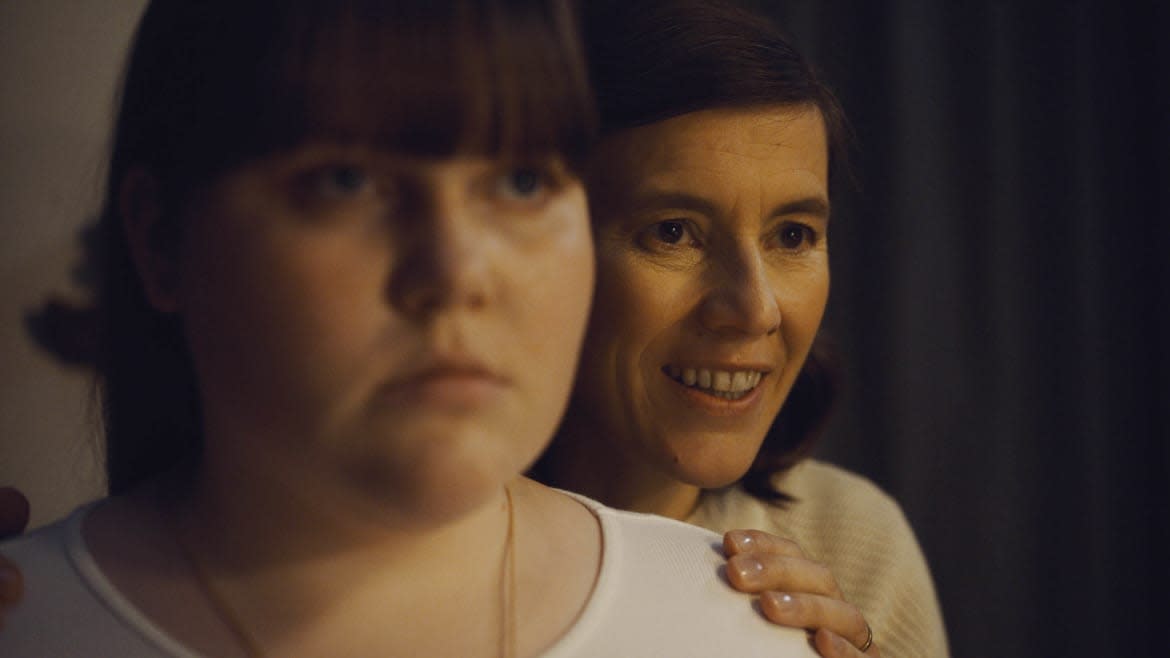Inside ‘Family Dinner,’ The Body-Horror Movie Grossing Out Tribeca

We’ve all had trying family visits during the holidays, but most of us have never faced a reunion as cursed as the Easter celebration at the center of Family Dinner.
Austrian writer/director Peter Hengl’s feature debut out of the Tribeca Film Festival keeps the proceedings understated at first, but by the end, the film’s carefully constructed dread gives way to real, visceral terror. While the true hideousness at the heart of Family Dinner is best left as a surprise, suffice it to say that the climax might leave viewers on edge for the next several family dinners to come.
Things seem pretty innocuous when 15-year-old Simi (Nina Katlein) first arrives at her aunt Claudia’s (Pia Hierzegger) home for an Easter celebration. Simi is nervous at first to ask her famous-nutritionist relative to help her lose weight but seems relieved when Claudia broaches the topic herself and agrees to place Simi on a new regimen through Easter Sunday. The first order of business? Starving Simi out for a few days to “detox” her body.
‘First Kill’ Is a Teen Lesbian Vampire Romance That Really Kind of Sucks
Anyone who’s struggled with body-image issues will recognize the gentle yet shame-ridden tone Claudia adopts when speaking with her niece; it’s a painfully accurate echo of meddlesome relatives everywhere. At every turn, Hengl highlights the deeper issues underpinning Claudia’s obsession with weight and “nutrition.” Her controlling behavior toward Simi is not unique but an exaggerated version of the same fearsome temper and lack of empathy Claudia exhibits for everyone around her, including her noxious son, Filip (Alexander Sladek).
It’s not just Simi’s aunt who seems a bit off, either; everyone in this house gives off terrible vibes. Claudia’s husband, Stefan (Michael Pink), might be nicer to his niece by marriage than Claudia is, but throughout Family Dinner, his plays at kindness feel creepy. Throughout the film, we catch small glimpses of the discomfort he stirs in Simi. At one point, she jerks awake from a nightmare in which he tries to sexually assault her in front of an empty refrigerator. Simi’s spoiled cousin Filip, meanwhile, seems to love nothing more than bullying her for no discernible reason.
The slow-simmering tension between Simi and Claudia sets the pace, as does Simi’s growing realization that the person she’s chosen to help “fix” her body might not be entirely okay—or even decent—herself.
Hengl lines up his scares with methodical restraint, interweaving Simi’s increasingly delirious hunger with gruesome discoveries like a decapitated rat and a foreboding manuscript for Claudia’s newest, most extreme book. The film’s script embraces a subtle approach that trusts viewers to connect the dots between its themes—between a wealthy family starving itself in the name of spiritual enlightenment and, in the same breath, denying a family member her humanity based solely on her weight. As Simi’s desperation grows, we observe her eyeing increasingly revolting potential meals—from leftovers set for the garbage, to a line of toothpaste, to scraps of a rabbit corpse.
But to return to that dead rat: If there’s one aspect of Family Dinner’s storytelling that tastes a little rotten, it’s Simi’s unbelievable naïveté. Both in film and real life, bigger people are often characterized as being stupid, lazy, or both. At times, Simi’s inability to discern where the real dangers around her lie feels forced. Beyond puncturing the film’s believability, her struggle to piece the puzzle together slows down the proceedings, especially in moments that a tighter film might have used as turning points.
At first, Simi believes it was Filip who left the dead rat on her pillow. That notion begins to fall apart when we watch him choke on a hunting trip, unable to slit a dying rabbit’s throat to end its misery. The significance of the moment never quite gets its due; although Simi seems to realize there might be more to her cousin than she thought, she never goes a step further to try and investigate who might have left the headless rodent on her pillow instead—or why they would have done so.
Visually, Family Dinner feels almost reminiscent of Valdimar Jóhannsson’s Lamb, another horror film with an eye for agrarian carnage and richly dyed textiles. Simi’s isolation at her aunt’s luxe estate is not only emotional but visual; her aunt’s brood consistently looks like they stepped out of a catalog, while she typically wanders the house in tight-fitting pajamas and hoodies. She doesn’t wear makeup like her aunt, and her hair is long with blunt bangs. Every layer of the production feels designed to emphasize how close to home life and death hit on this country estate—and just how alone Simi feels within it.
But there’s more to this film than your average brooding thriller. By the end, Simi discovers the dark truth of her aunt’s recent research—and why no publisher seems to want to touch the manuscript despite the enormous success of Claudia’s previous work. By the time Simi finally sits down to Easter dinner, the main course is a heaping plate of dramatic irony—the kind that leaves a deliciously revolting aftertaste. Good luck getting it out of your mouth before your next meal.
Get the Daily Beast's biggest scoops and scandals delivered right to your inbox. Sign up now.
Stay informed and gain unlimited access to the Daily Beast's unmatched reporting. Subscribe now.

